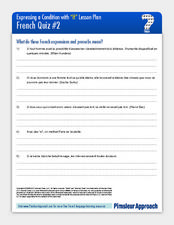Curated OER
Pero y Sino
It's tough to distinguish between pero and sino; review the definition and use for each, and then provide your Spanish class with this practice opportunity. There are only 10 questions, and you learners must decide which word fits in...
Curated OER
Indirect Object Pronouns
Beginning Spanish language learners review indirect object pronouns with this resource. Pupils choose the indirect object pronoun that completes the sentence the best.
Curated OER
Muy vs. Mucho
What is the difference between muy, mucho, mucha, muchos, etc? Assess your Spanish speakers and their understanding of these words. For each sentence, they choose the word that fits the best. Answers are provided, but you might want to...
Curated OER
I Know My Colors
How well does your beginning Spanish class know their colors? Give them this quick coloring worksheet to find out. Each shape is paired with a color (in Spanish), and youngsters must color the shape with its corresponding color. A fun...
Curated OER
Practica de Pronunciación y Ortografía: sa, se, si, so, and su
As the teacher reads the list of words provided, each pupil attempts to record the missing syllable combination on their list of incomplete words. There are 20 words, and the missing syllable combinations are: sa, se, si, so, and su.
Curated OER
Colors
How well does your beginning Spanish class know its colors? Use this activity (which could also be used as a quiz) to assess their recall and recognition. There are four activities here which ask them to recall the Spanish words for...
Curated OER
Gustar and Similar Verbs
The -ar verbs gustar and encantar are often confusing to non-native speakers, so give your beginning classes this reference guide to help them understand the shift in sentence formation. The well-organized charts are effective and clear,...
Curated OER
School to Home Link: Describing Events
Help your young native Spanish speakers develop description skills. With this school-to-home learning exercise, parents will help their youngster write a story that uses details. Both the parent and child are asked to sign the sheet-- a...
Curated OER
Present IR Verbs
Focus on -ir verbs with your beginning Spanish speakers. After you've introduced common -ir verbs and their conjugations, give your class this practice opportunity. They read the short sentences provided and choose the verb conjugation...
Curated OER
Es un terremoto!
It's true! As your class reads the article, earthquakes are happening all around the world. Entice your Spanish class with this reading assignment, focusing on earthquakes, and assess their reading comprehension by having them answer the...
Curated OER
Present Irregular 1
Have your Spanish language learners memorized the list of irregular verbs in the present tense? Introduce your class to some irregular verbs, and then distribute this exercise. Some of the verbs aren't terribly common in every day...
Curated OER
Indefinite Pronouns
How do you use indefinite pronouns in the Spanish language? After introducing your language learners to indefinite pronouns, provide them with this practice opportunity. They read the sentence provided and choose the indefinite pronoun...
Curated OER
AR Verbs
Focus on -ar verbs with this practice opportunity. Learners recall regular -ar verb endings, translate a list of verbs into Spanish -ar verbs, and complete a short fill-in-the-blank activity that focuses on conjugation. A great resource!
Curated OER
Indefinite Articles
After introducing your beginning Spanish speakers to indefinite articles, provide them with this quick practice opportunity. For each word provided, learners choose from four indefinite articles. There are 32 questions.
Curated OER
Division of Syllables
Study diphthongs in the Spanish language. This resource contains a lot of information, so consider printing one for each learner to reference and walking them through it as a class. There is a short exercise at the bottom of the page to...
Curated OER
Present Perfect 1
Your intermediate and advanced Spanish speakers review the present perfect. Several example sentences are given, and learners have to choose which conjugated verb fits in each sentence correctly.
Curated OER
El verbo tener-Explanation
Introduce your beginning Spanish speakers to the verb tener. The chart at the top of the page details the basic present tense conjugation, and the examples that follow show the different ways that tener is used. While no practice...
Curated OER
Les Formes
What shape is a can of soda? What about a book? Develop basic shape vocabulary with your beginning French speakers. They learn nine shapes, adjectives that correlate to shapes (like if something is cylindrical, it's cylindrique), and...
Curated OER
French Idioms With "If"
Your intermediate French speakers study a series of five French proverbs (all using si + le conditionnel). Can they explain what each proverb or idiom means? Answers are not included here, but it might be interesting to break learners...
Curated OER
French Holidays
How much do your French students know about holidays in France? A printable resource presents 13 French holidays, including Toussaint, Fête Nationale, and Jour de I'an, along with dates and descriptions for each.
Curated OER
J'aime l'école!
Bienvenue à l'école! Read the short story, learn the eight vocabulary words presented here, and complete the two-part exercise. Beginning Francophones will learn the words: histoires, l'école, crayons de couleur, le bureau, écrire, la...
Curated OER
What are they doing?
Teach beginning French speakers 10 common verbs. They use the pictures included to identify the correct French verb. The verbs listed are s'asseoir, s'accroupir, s'agenouiller, s'allonger, s'étirer, se pencher, se rencontrer, se...
Curated OER
Jobs and Professions Grammar Worksheet
Some words need to change in order to be used in their feminine forms. While focusing on jobs and professions, review the words that need that extra e in their feminine form. Also, distinguish between the words that get the ending -teuse...
Curated OER
Oral Activity: Camping
Review camping vocabulary terms with your French language learners. Pair your learners up to practice the brief dialogues provided here. Each member in the pair gets a different sheet, and learners practice asking and answering questions.

























